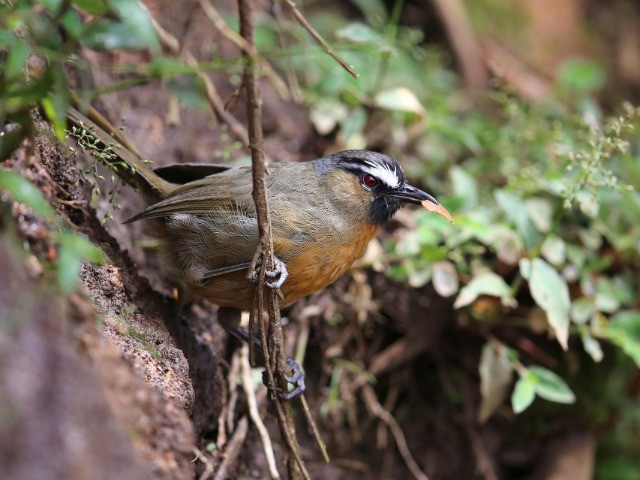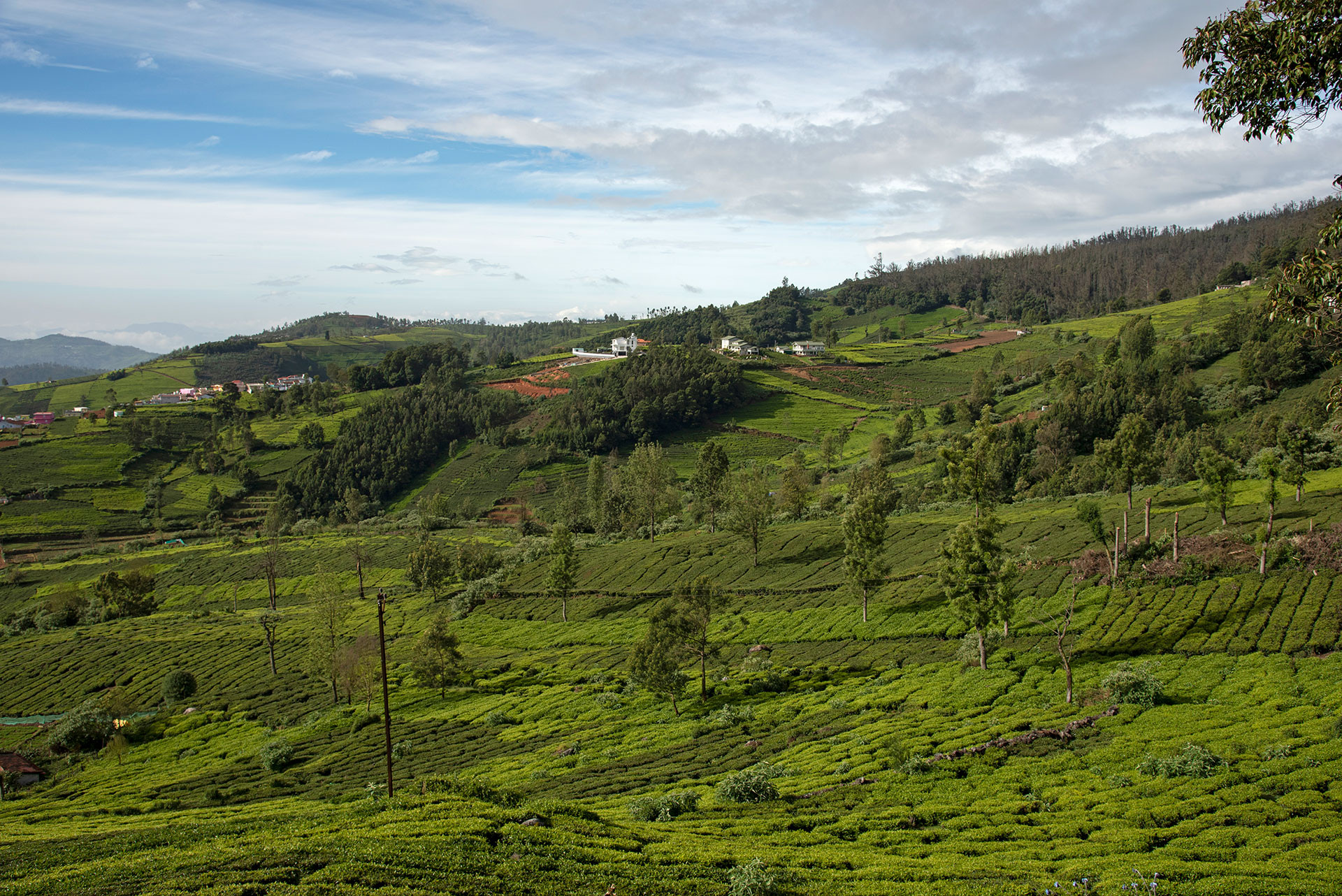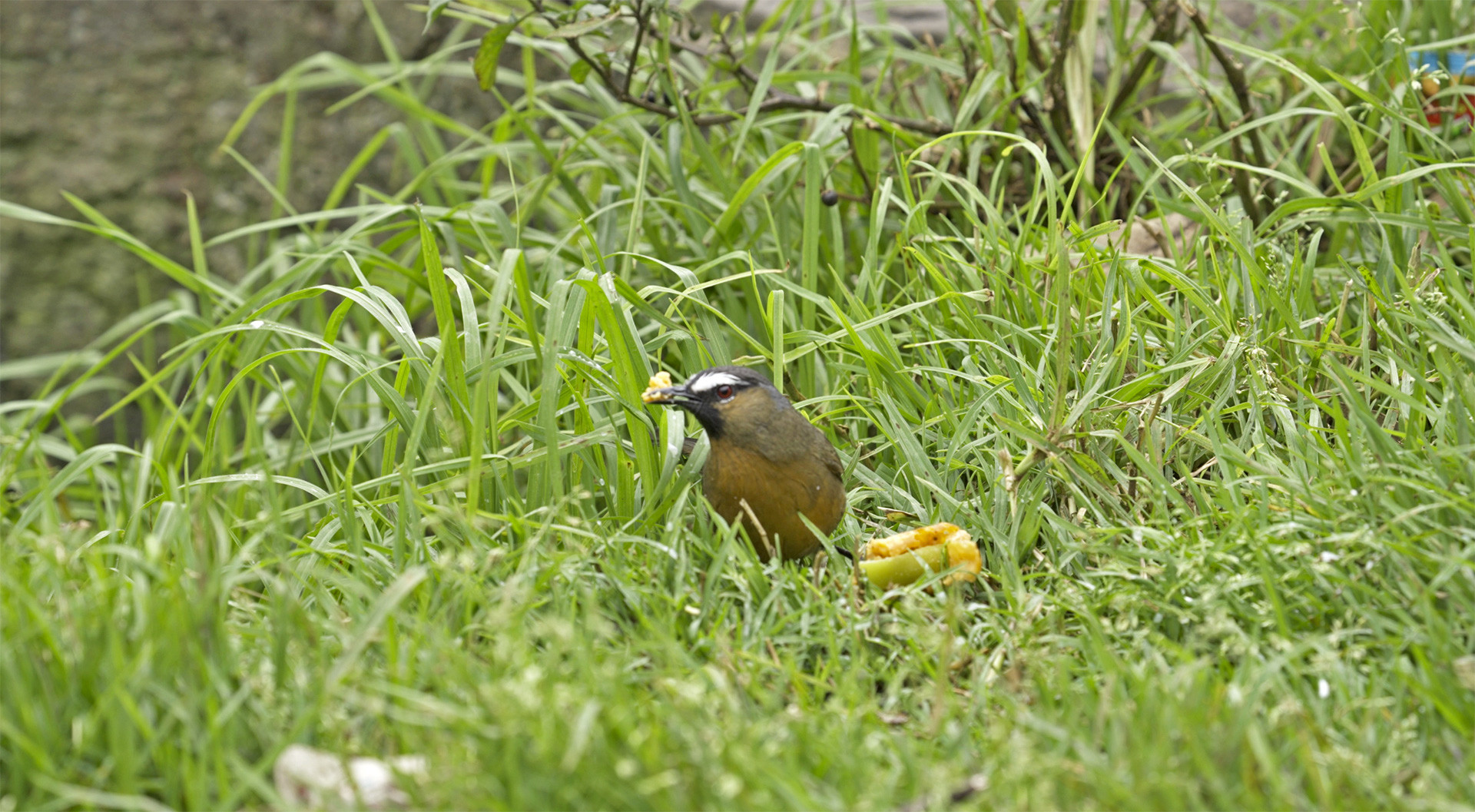This is the second story in a series of articles on the Western Ghats—covering everything from elusive frogs to majestic birds to hidden ancient forests.
A melodious cackle rose up from the valley—a-ha-ha-haw-a-ha-ha-haw-a-ha-ha-haw! I smiled as another hit the air. This one was louder. Closer. I thought I spotted a tail in the undergrowth, or maybe the tip of a wing, but I wasn’t sure. Next to us, stunted shola trees with broccoli-top canopies swayed in the cold breeze that was beginning to rise to the top of the mountain. A thick mist followed. The rolling grassland scape around us had gone from a gaudy green to pale white. Six feet away, our guide huddled into the warmth of his jacket; he was now just a grey silhouette. More cackles; the birds were all around us! A cloud sneaked upon us, and without any warning, it burst. We scrambled to pack up our camera equipment and prepared to walk down the steep mountain in blinding rain and slush. Rain in the Nilgiris is as rough and unforgiving as the terrain. We were on our third day already, and true to its character, the Nilgiri Laughingthrush continued to be elusive.
Endemic to the Nilgiri Hills of the Western Ghats, the Nilgiri Laughingthrush (Montecincla cachinnans) favours high-altitude cold, wet habitats. As it goes about skulking in the dark undergrowth of the evergreen shola forests, the one thing that gives away its presence is the striking white eyebrow. The black chin, red eyes and white supercilium contrast beautifully with its bronze-brown body. The Nilgiri Laughingthrush is usually seen in pairs, foraging close to the forest floor, moving quickly through bushes, occasionally flying right up to the canopy of those short shola trees, and almost always flying away without warning. The calls and songs are distinct, ranging from raspy grunts and chatter to complex cackles and duets that the pairs perform. Their loud, merry, sometimes maniacal laugh-like songs are unmistakable and will bring a smile to one’s face every single time. All is not well, though, where the bird is concerned. Conversion of forest land for agriculture and tea plantations and degradation of forests due to the rampant growth of invasive species has resulted in habitat loss, which puts the bird in danger. The IUCN Red List has classified the bird as Endangered, and the fact that the bird is found only in the Nilgiri Hills and nowhere else in the world puts it at higher risk.
A day later, we walked into a forest fragment at the edge of a tea plantation. A century ago, the plantation must have been a lush green grassland. Now, Red-whiskered Bulbuls hovered over tea bushes, in this green desert. The forest though, was dense. The canopy was like a green cloak overhead, and birdsong echoed through the trees. A stream kept us company throughout the walk. Wherever I looked, I saw sinuous branches with various adornments—orchids, fern, moss, vines, lichen, fungi and more. I could barely see a shade of brown on tree trunks. It was all magically green, and if someone told me that fairies lived there, I would believe them in an instant. We were in the heart of an evergreen tropical montane forest, known as a shola forest. The word ‘shola’ originates from the Dravidian word solai, which means ‘forest grove’. Shola forests occur in the folds and depressions of mountains, and at the bottom of valleys and on some windswept hill faces. Shola forest patches on the undulating hills of the Western Ghats are connected by montane grasslands, creating a beautiful patchwork with many shades of green. Together, they form what is called the shola-grassland mosaic, home to a diverse ensemble of species of flora and fauna. In the Nilgiris, it is in this kind of habitat that the Nilgiri Laughingthrush lives and thrives, so our hopes of seeing the bird in this forest patch were sky-high.
Bird activity picked up around us and we set up our cameras. A Black-and-orange Flycatcher shot out of the canopy and settled down on a bush right next to us, moving its slender tail up and down as it called. I decided right then that I hadn’t seen a more beautiful blob of a bird, ever. A Nilgiri Flycatcher called out nearby; the endemic Nilgiri Sholakili joined in with its dulcet tones. A trio of Grey-headed Canary Flycatchers crowded around a moss-laden liana. I found it hard to pick a subject to focus on. I loved how I was spoilt for choice. But the bird we were looking for, the Nilgiri Laughingthrush, was yet to make an appearance. I could hear a pair of them dueting, but they just wouldn’t show up.
Formerly known as the Black-chinned Laughingthrush or the Rufous-breasted Laughingthrush, the Nilgiri Laughingthrush now has a new name—Nilgiri Chilappan. The bird was previously grouped under the genus Garrulax with other passerines of the laughingthrush family. A seminal study by V.V. Robin, an Assistant Professor at IISER Tirupati, and his team, resulted in the creation of a new genera, Montecincla. The study also revealed the fascinating evolutionary history of the bird—how it diverged from its Himalayan relatives about five million years ago during the Miocene and settled on the highest reaches of the Western Ghats. When peninsular India experienced dramatic climatic changes, the bird continued to track these microclimatic conditions and finally isolated itself in the montane “cloud forests” or “sky islands” of the Nilgiri Plateau.
Four species of birds belong to the genus Montecincla and can be found in various regions and elevations of the Western Ghats—Nilgiri Laughingthrush (Montecincla cachinnans) in the Nilgiri Plateau, Palani Laughingthrush (Montecincla fairbanki) in the Kodaikanal region, Banasura Laughingthrush (Montecincla jerdoni), in an extremely restricted range around the Banasura Hill in Kerala, and the Ashambu Laughingthrush (Montecincla meridionalis) in southern Kerala and Tamil Nadu.
The Nilgiri massif connects two long mountain ranges, the Western Ghats and the Eastern Ghats, with an average elevation of about 2100 metres, and many peaks towering at over 2500 metres. It is a biodiversity hotspot, with a wide array of habitats, flora and fauna, some of which are not seen anywhere else in the world. The Nilgiri Hills are also home to many groups of indigenous people, such as the Toda, Kurumba, Muduga and Kota. The landscape in the Nilgiris has gone through a drastic transformation over the last 200-odd years. Estimates show that around 70 per cent of the Nilgiri Plateau was once covered with grassland vegetation. Almost everything was removed to make way for tea and exotic tree plantations, and only about 7 per cent of that remains today. With its high commercial value, tea will continue to be the dominant plant species here for a long time.
Monocrop plantations of wattle (Acacia sp.), eucalyptus, pine, and invasive species such as solanum, eupatorium, cestrum, lantana and gorse are rampant and often seen even in some remote shola forest patches. Non-native plants displace native shola-grassland vegetation and spread across the landscape prolifically, affecting the local plant and animal diversity and also draining natural water resources. However, one of the most abundant species of non-native plants in the Nilgiris is a kind of grass from Africa, called Kikuyu (Pennisetum clandestinum). The grass takes over entire mountains, making everything look deceptively green, but affects native vegetation severely. All is not lost, though. Godwin Vasanth Bosco, an ecologist and a resident of the Nilgiris, is working towards restoring native shola-grassland vegetation by organising planting projects and setting up nurseries. Organisations like Keystone Foundation in Kotagiri are playing a crucial role in restoring shola-grassland habitats by working with local residents and indigenous communities. By restoring the waterways in shola forests, and planting native species, they hope that the forests will be able to host wildlife again.
Our quest to film the bird often led us to forest fragments that border tea or tree plantations because finding a shola forest that’s not around one is just not easy. It’s not easy for animals either. Large herds of Indian Gaur are a constant presence in tea plantations in many parts of the Nilgiris. Barking Deer, Sloth Bears, leopards, tigers, elephants and various other small and large mammals use tea plantations to move about, feed and breed. Other than the thrill of watching wildlife in such unexpected locations, these sightings barely surprised us anymore. On a cloudy, cold morning, as we slowed down to negotiate a steep curvy bend in the road, the song of the Nilgiri Laughingthrush rose from the valley; so loud that we could hear it clearly over the din of traffic. When we looked around, it was all tea, and a handful of shops selling tea and snacks. A herd of gaur grazed peacefully in the plantation closest to the road, as tourists stopped to take pictures of them, and a few selfies with them. We stopped to scan the plantations, in the hope of seeing the bird, and for a hot cup of tea, because, why not! Curious to find out if local residents recognise the bird, I pulled up a photograph on my phone and asked a couple of people if they’ve seen the bird. One of them hadn’t, but another had seen a similar-looking bird further up the road, near a busy tea stall. The crowded stall he pointed at sat at the edge of a tea plantation and a shola forest lined with wattle and had a breathtaking view of the valley below. It was a tourist hotspot. What it also had was garbage that tourists had casually tossed out after snacking and drinking.
Sumathi, who runs the tea stall, greeted me with a warm smile and said yes, she recognises the bird because she sees it every single day when it visits the garbage dump behind the stall. My heart sank. This is not the kind of place or situation that I wanted to see the bird in. We set up our cameras and waited as a constant stream of cars pulled up, loaded with tourists bundled up in warm clothing. People hopped off their cars, rushed to take pictures of the scenery and then rushed to order tea and snacks—it was the same with every group that arrived. Down below in the garbage dump, something similar unfolded. Small flocks of Red-Whiskered Bulbuls and Great Tits took turns to forage in the garbage. Discarded raw banana and chilli fritters, instant noodles, fried snacks—the birds seemed to have developed an appetite for everything we eat. An Indian Blackbird gave them company once in a while, as did a pair of Nilgiri Flycatchers. A Painted Bush Quail bobbed around at the edge of the dump, while a Grey Junglefowl foraged nearby, shouting out its metallic call incessantly. And then, just like that, a pair of Nilgiri Laughingthrushes arrived and settled on a tea bush. We scrambled to film them, as they took their time observing the scene. One of them hopped up to a half-eaten chilli fritter lying in the grass, pecked into it, and flew away with a large chunk. The second bird hopped to the same spot and flew away with another piece of the fritter in its beak. I couldn’t believe they were eating discarded fried food! I couldn’t believe it had come down to this.
Over five million years, the Nilgiri Laughingthrush has witnessed and lived through many changes. It is an undeniable truth that the bird is a great survivor. The fact that the bird is now moving out of forests and feeding on human refuse could mean many things—that the landscape has gone through an irreversible change, or that the bird is finding new ways to cope, or something else that we haven’t observed or figured out yet. Maybe they are doing well, maybe they aren’t. The species has survived, but the means by which it is surviving, I don’t know what to make of that.
Watch the mini-documentary on the Nilgiri Laughingthrush here:
















